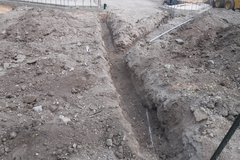Archaeological fieldwork for the Main Gate and Lunette and Plaza de Valero came to an end this week. The project has shifted to above-ground construction activities. As a result, this will be the final weekly archaeology update for this phase of the project.
For this last week archaeologists monitored grading around trees during the removal of a landscaping planter and trenching for installation of electric and irrigation conduits.
After air spading around the protected trees last week, a portion of the northernmost landscaping planter remained (Figure 1). This portion of the above-ground planter was removed early this week. After removal of the planter, the area was graded to a level equal with the rest of the Project Area. Grading resulted in minimal soil removal, approximately 4 inches below the base of the planter was impacted but most of the soil was spread across the NE area and not hauled off.
The trenching for the electrical conduits also continued this week. The trenches were approximately 2 ft wide and went to a depth of approximately 18 inches below surface (Figure 2). The approximate length that was excavated this week was 20 ft. Soils were a sandy clay loam mix (10YR 5/2) and appeared to be introduced fill. No cultural materials were observed. The trenches were placed along the eastern boundary the Project Area. After the conduits were installed, the trenches were backfilled.






